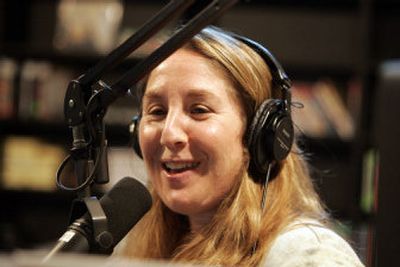Radio’s indie streak

SEATTLE – Before dawn on a rainy Friday, John Richards totes a stack of CDs and a paper cup of coffee into the booth at KEXP. On the wall, yellow-headed pins stuck in a world map mark the origin of song requests.
Baltimore. Boston. Baghdad.
The clock hits 6 a.m., and the DJ’s catchy, gentle theme song – written for him by local folk singer Damien Jurado – provides an outline of what listeners might hear: “I’ll take hip-hop, with a side of punk rock, some country western to go … .” Next up, Stone Roses, followed by Clap Your Hands Say Yeah.
In Redmond, just across Lake Washington but beyond KEXP’s meager 3,300-watt signal, Microsoft employee Peter Thompson is up early, listening on the Internet as he works to meet a deadline. Two thousand miles farther east, in Columbus, Ohio, Pat Leonard is at his cubicle, slipping on his headphones. And in Rhode Island, Cynthia Reed is on her way to work, where she will blast the station all morning in her work room at the Providence Public Library.
“Anywhere we can liberate people from bad radio,” Richards says.
In the past few years, commercial-free KEXP has embraced, and, thanks to a University of Washington partnership, even created technology to overcome its limited signal and emerge as a national tastemaker in indie music.
With very few other like-minded stations, it’s enjoying a word-of-mouth-fueled popularity boom even as Americans in general are tuning in less – two hours a week less than they were in 1998, according to Arbitron.
“Clearly, what has driven the success of these stations is what’s been happening in commercial radio: The playlists have gotten narrower and narrower and the commercial loads have gotten heavier,” says Roger LaMay, general manager of noncommercial WXPN in Philadelphia. “Increasingly, the artists turn to these stations because it’s the only place they can get their music played. We look for artists and embrace them.”
In spring 2004, about 26,000 people listened to KEXP online every week – more than any other radio station in the country, according to Arbitron’s now-defunct Internet broadcasting service. This year, that number has jumped to 50,000, with large clusters of listeners in New York, where KEXP broadcasts live twice a year; Chicago; San Francisco; and Washington, D.C. Listeners are giving the nonprofit station a projected $1.7 million this year, nearly $1 million more than they gave in 2003.
“It’s commercial-free. They play what they want,” says Seattle KEXP listener Traci Sheehan. “You can tell the DJs are real people, not reading a script.”
Technological advances have helped drive KEXP.
In 2000, the station became the first to offer uncompressed, CD-quality audio live over the Internet. In 2001, at the request of KEXP DJs, University of Washington engineers invented CD players that could connect to the Web to retrieve song and band information, which could then be transferred to a real-time playlist at www.kexp.org. The next year, the station began offering a streaming archive of all programs from the past two weeks, as well as all of KEXP’s hundreds of in-studio performances.
This summer, KEXP began offering hour-long podcasts featuring unsigned bands and became the nation’s first terrestrial station to provide a low-bandwidth stream for cell phones and handheld devices. Richards heard recently from one fan who had plugged his phone into his car stereo and was driving around Gainesville, Fla., listening to KEXP.
But the technology is just a way to spread KEXP’s music, and the station’s format hasn’t changed in the past two decades, says executive director Tom Mara. Back then, KEXP was KCMU, a decidedly less professional UW station, founded in 1972 and closely linked to Nirvana, Mudhoney and Seattle’s burgeoning rock scene.
Things changed dramatically in 2001, when KCMU entered a partnership with Paul Allen’s Experience Music Project and became KEXP. Allen, Microsoft’s co-founder, gave the station new equipment and new off-campus digs next to an abandoned strip club, and agreed to cover the operating losses through 2005. In 2002, the music museum paid for 52 percent of the station’s budget. This year, it covered 6 percent, and by next year, KEXP should be in the black.
“They’re proving, if people would really look, that listeners want compelling music, that they’ll buy it, that they’ll support it,” said Steve Nice, who represents the band Idlewild, which recently played at KEXP.
Many commercial stations hand DJs a restrictive list of songs to play, although some stations are now turning to “Jack” and “Bob” formats – essentially, a bunch of hits from various genres on shuffle.
At KEXP, the DJs choose what they play, with a few limitations: Certain bands are in rotation, and a local band must be played once an hour at minimum. The station’s dozens of volunteers dedicate themselves to helping discover bands. The DJs consider themselves curators and aspire to juxtapose songs in a way that illuminates them.
“It’s all about creating context for the music,” says afternoon host Kevin Cole. “Take Clap Your Hands Say Yeah – if you can mix that into some early Talking Heads, you can see, ‘Oh yeah, that’s what’s going on here.’ “